High Accuracy Localization Scheme Using 1-Bit Side Information: Achievability from a GDoP Perspective
Abstract
1. Introduction
- –
- Combination of Channel Impulse Response (CIR) based fingerprinting positioning and iterative-ToA real-time positioning methods
- –
- Non Line of Sight (NLoS) mitigation algorithms were used to improve incorrect location estimates corrupted by NLoS errors and proposed a cellular-based location tracking system.
- –
- Analysis of the optimal geometry for the two-dimensional ToA localization configurations based on minimizing the area of estimation confidence region
- –
- A new grid search-based technique was proposed to solve the constraint, nonlinear, underdetermined Equations for wireless location in NLoS environments
- –
- A novel algorithm for reducing error called TSE computing estimates and updating the location vector
- –
- ToA method with low computational complexity
- Machine learning-based localization method [24]
- –
- Application of ANN and RBF neural network to localization methods with ToA measurements
- Our work
- –
- Proposal of position correction method which applies to existing artibrary positioning schemes.
2. System Model
3. Preliminaries on GDoP
4. ToA-Based Positioning Technology Using Additional Information
- Owing to the absence of external positioning points in space S0, the position is estimated using only the general ToA. In space S1, located outside the user space, the ToA value is used for measurement, and an additional method is employed to adjust the positioning point within this space;
- Two methods are available for correcting points in the S1 space. The first method involves using the anchor point located at the closest corner of the user space. The second method involves correcting points outside the space by considering the intersection formed by the center point of the user space and the anchors, with straight lines passing through them;
- Two methods are available for correcting points in the S2 space. The first method corrects the external point by lowering it perpendicularly to the user space formed by the anchor, while the second method corrects the external point using the intersection of the user space and the straight line passing through the center point of the user space. Table 1 provides an overview of the correction methods employed for each area in relation to the position estimation values.
4.1. Scheme #1
4.2. Scheme #2
4.3. Scheme #3
5. Performance Analysis
5.1. Simulation Environment
5.2. Simulation Result
5.2.1. Average Positioning Error Perspective
5.2.2. CDF Perspective of Mean Positioning Error
5.3. Discussion
6. Conclusions
Author Contributions
Funding
Institutional Review Board Statement
Informed Consent Statement
Data Availability Statement
Conflicts of Interest
References
- Jiang, W.; Han, B.; Habibi, M.A.; Schotten, H.D. The road towards 6G: A comprehensive survey. IEEE Open J. Commun. Soc. 2021, 2, 334–366. [Google Scholar] [CrossRef]
- Hunukumbure, M.; Kolawole, O.Y.; Gutierrez-Estevez, D.M. Optimising UWB based location tracking in smartphones through the support of 5G. In Proceedings of the 2022 IEEE International Conference on Consumer Electronics (ICCE), Las Vegas, NV, USA, 7–9 January 2022. [Google Scholar]
- Chen, Y.-Y.; Huang, S.-P.; Wu, T.-W.; Tsai, W.-T.; Liou, C.-Y.; Mao, S.-G. UWB System for indoor positioning and tracking with arbitrary target orientation, optimal anchor location, and adaptive NLOS mitigation. IEEE Trans. Veh. Technol. 2020, 69, 9304–9314. [Google Scholar] [CrossRef]
- Shin, B.J.; Lee, K.W.; Choi, S.H.; Kim, J.Y.; Lee, W.J.; Kim, H.S. Indoor WiFi positioning system for android-based smartphone. In Proceedings of the 2010 International Conference on Information and Communication Technology Convergence (ICTC), Jeju, Republic of Korea, 17–19 November 2010. [Google Scholar]
- Bisio, I.; Cerruti, M.; Lavagetto, F.; Marchese, M. A trainingless wi-fi fingerprint positioning approach over mobile devices. IEEE Antennas Wirel. Propag. 2014, 13, 832–835. [Google Scholar]
- Koivisto, M.; Hakkarainen, A.; Costa, M.; Kela, P. High-efficiency device positioning and location-aware communications in dense 5G networks. IEEE Commun. Mag. 2017, 55, 188–195. [Google Scholar] [CrossRef]
- Liu, Y.; Shi, X.; He, S.; Shi, Z. Prospective positioning architecture and technologies in 5G networks. IEEE Netw. 2017, 31, 115–121. [Google Scholar] [CrossRef]
- An, J.; Yuen, C.; Dai, L.; Renzo, M.D.; Debbah, M.; Hanzo, L. Near-field communications: Research advances, potential, and challenges. IEEE Commun. Mag. 2024, preprint. [Google Scholar]
- Wang, Y.; Huang, S.; Yu, Y.; Li, C.; Hoeher, P.A.; Soong, A.C.K. Recent progress on 3GPP 5G positioning. In Proceedings of the 2023 IEEE 97th Vehicular Technology Conference (VTC2023-Spring), Florence, Italy, 20–23 June 2023; pp. 1–6. [Google Scholar] [CrossRef]
- 3GPP TR 38.855 V16.0.0; Study on NR Positioning Support (Release 16). Wireless Technologies and Systems Committee: Washington, DC, USA, 2019.
- 3GPP TR 38.857 V17.0.0; Study on NR Positioning Enhancements (Release 17). Wireless Technologies and Systems Committee: Washington, DC, USA, 2021.
- Neburka, J.; Tlamsa, Z.; Benes, V.; Polak, L.; Kaller, O.; Bolecek, L.; Sebesta, J.; Kratochvil, T. Study of the performance of RSSI based Bluetooth smart indoor positioning. In Proceedings of the 2016 26th International Conference Radioelektronika (RADIOELEKTRONIKA), Kosice, Slovakia, 19–20 April 2016. [Google Scholar] [CrossRef]
- Xu, J.; Ma, M.; Law, C.L. Aoa cooperative position localization. In Proceedings of the IEEE GLOBECOM 2008—2008 IEEE Global Telecommunications Conference, New Orleans, LA, USA, 30 November–4 December 2018. [Google Scholar] [CrossRef]
- Alsindi, N.; Li, X.; Pahlavan, K. Analysis of time of arrival estimation using wideband measurements of indoor radio propagations. IEEE Trans. Instrum. Meas. 2007, 56, 1537–1545. [Google Scholar] [CrossRef]
- Qi, Y.; Kobayashi, H.; Suda, H. On time-of-arrival positioning in a multipath environment. IEEE Trans. Veh. Technol. 2006, 55, 1516–1526. [Google Scholar] [CrossRef]
- Wang, X.; Wang, Z.; O’Dea, B. A ToA-Based Location Algorithm Reducing the Errors Due to Non-line-of-Sight (NLOS) Propagation. IEEE Trans. Veh. Technol. 2003, 52, 112–116. [Google Scholar] [CrossRef]
- Chen, P. A cellular based mobile location tracking system. In Proceedings of the 1999 IEEE 49th Vehicular Technology Conference (Cat. No.99CH36363), Houston, TX, USA, 16–20 May 1999; Volume 3, pp. 1979–1983. [Google Scholar]
- Zheng, Y.; Sheng, M.; Liu, J.; Li, J. Exploiting AoA estimation accuracy for indoor localization: A weighted AoA-based approach. IEEE Wirel. Commun. Lett. 2019, 8, 65–68. [Google Scholar] [CrossRef]
- Wylie, M.; Holtzman, J. The nonline of sight problem in mobile location estimation. In Proceedings of the ICUPC—5th International Conference on Universal Personal Communications, Cambridge, MA, USA, 2 October 1996; pp. 827–831. [Google Scholar]
- Kabir, M.H.; Kohno, R. A hybrid ToA-fingerprinting based localization of mobile nodes using UWB signaling for non line-of-sight conditions. Sensors 2012, 12, 11187–11204. [Google Scholar] [CrossRef] [PubMed]
- Shen, J.; Molisch, A.F.; Salmi, J. Accurate passive location estimation using toa measurements. IEEE Trans. Wirel. Commun. 2012, 11, 2182–2192. [Google Scholar] [CrossRef]
- Wu, S.; Zhang, S.; Xu, K.; Huang, D. Neural network localization with ToA measurements based on error learning and matching. IEEE Access 2019, 7, 19089–19099. [Google Scholar] [CrossRef]
- Li, B.; Zhao, K.; Shen, X. Dilution of precision in positioning systems using both angle of arrival and time of arrival measurements. IEEE Access 2020, 8, 192506–192516. [Google Scholar] [CrossRef]
- Ross, S.M. Stochastic Processes; John Wiley & Sons, Inc.: New York City, NY, USA, 1996. [Google Scholar]
- Bhaskar, S.A. Localization from connectivity: A 1-bit maximum likelihood approach. IEEE/ACM Trans. Netw. 2016, 24, 2939–2953. [Google Scholar] [CrossRef]
- Alhmiedat, T. Fingerprint-based localization approach for WSN using machine learning models. Appl. Sci. 2023, 13, 3037. [Google Scholar] [CrossRef]
- Sedighi, S.; Mishra, K.V.; Shankar, M.R.B.; Ottersten, B. Localization performance of 1-bit passive radars in NB-IOT applications. In Proceedings of the 2019 IEEE 8th International Workshop on Computational Advances in Multi-Sensor Adaptive Processing, Le gosier, Guadeloupe, 15–18 December 2019; pp. 156–160. [Google Scholar] [CrossRef]
- Zheng, Y.; Wang, H.; Wan, L.; Zhong, X. A placement strategy for accurate toa localization algorithm. In Proceedings of the 2009 Seventh Annual Communication Networks and Services Research Conference, Moncton, NB, Canada, 11–13 May 2009. [Google Scholar] [CrossRef]
- Xie, Y.; Wang, Y.; Zhu, P.; You, X. Grid-search-based hybrid ToA/AoA location techniques for NLOS environments. IEEE Commun. Lett. 2009, 13, 254–256. [Google Scholar] [CrossRef]
- Nguyen, N.H.; Doğançay, K. Optimal geometry analysis for multistatic toa localization. IEEE Trans. Signal Process. 2016, 64, 4180–4193. [Google Scholar] [CrossRef]
- Kim, K.Y.; Shin, Y. A distance boundary with virtual nodes for the weighted centroid localization algorithm. Sensors 2018, 18, 1054. [Google Scholar] [CrossRef]
- Zou, Y.; Liu, H. A simple and efficient iterative method for toa localization. In Proceedings of the ICASSP 2020—2020 IEEE International Conference on Acoustics, Speech and Signal Processing (ICASSP), Barcelona, Spain, 4–8 May 2020. [Google Scholar]
- Lv, X.; Liu, K.; Hu, P. Geometry influence on GDOP in ToA and AoA positioning systems. In Proceedings of the 2010 Second International Conference on Networks Security, Wireless Communications and Trusted Computing, Wuhan, China, 24–25 April 2010. [Google Scholar] [CrossRef]
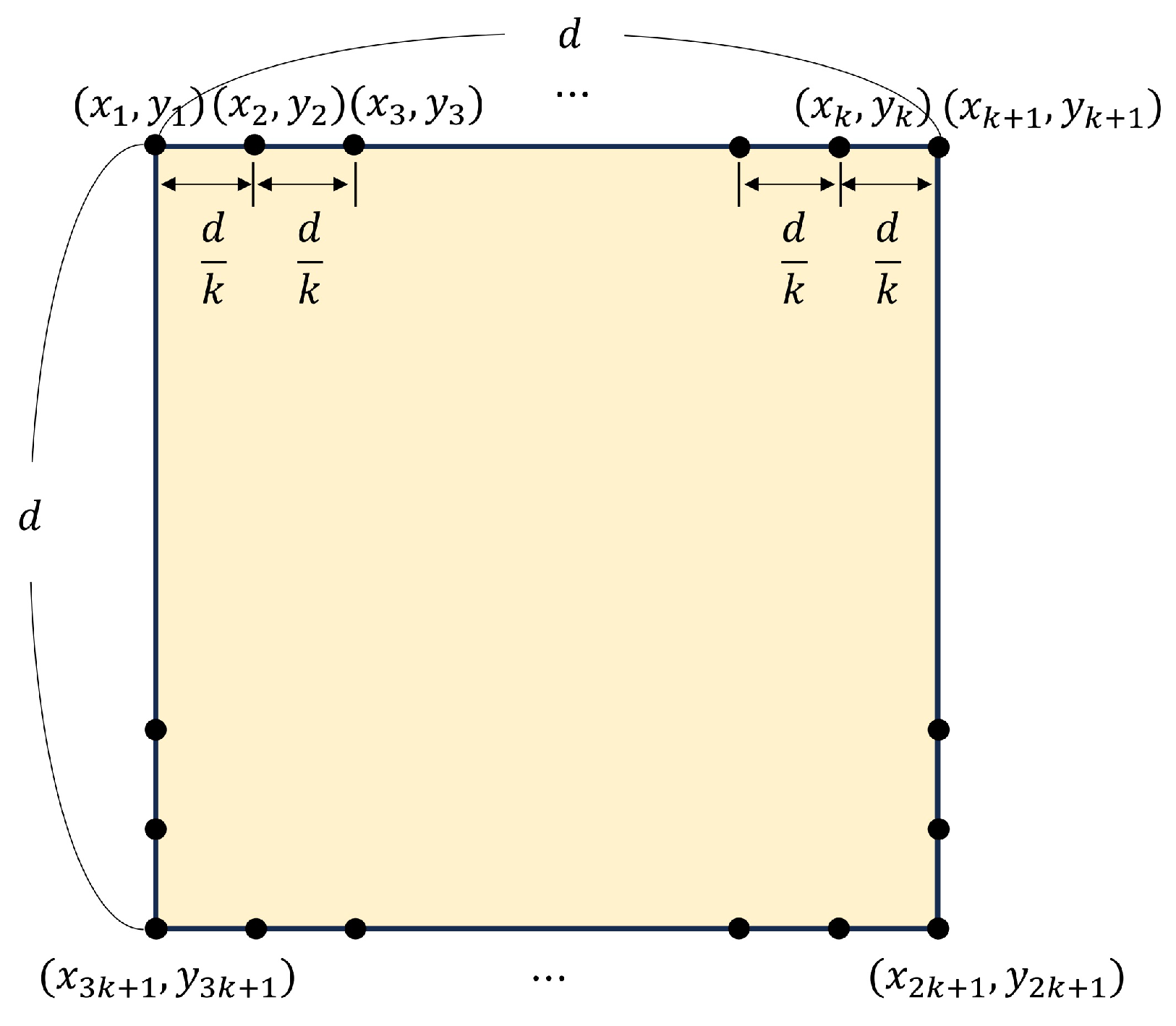
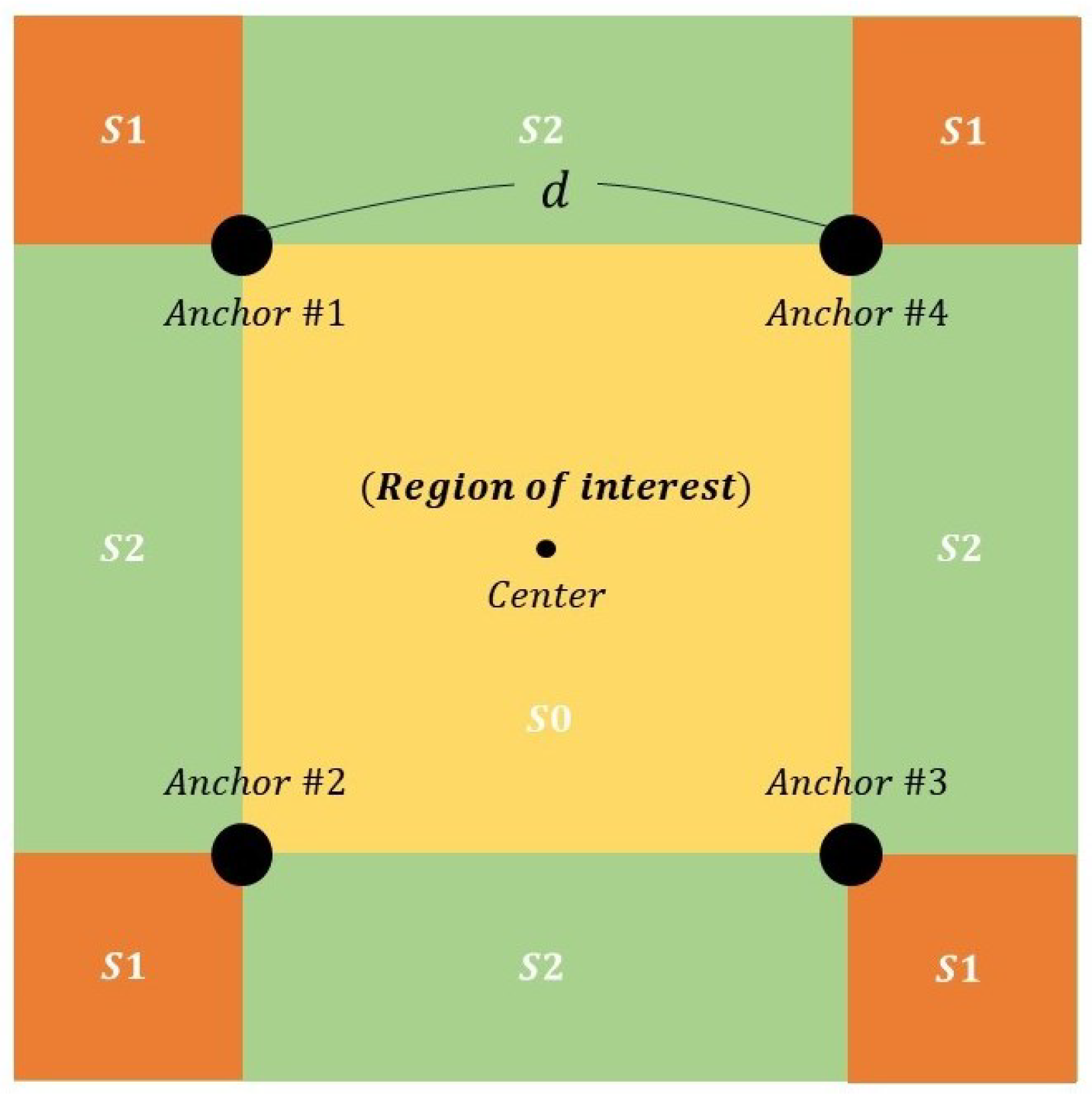
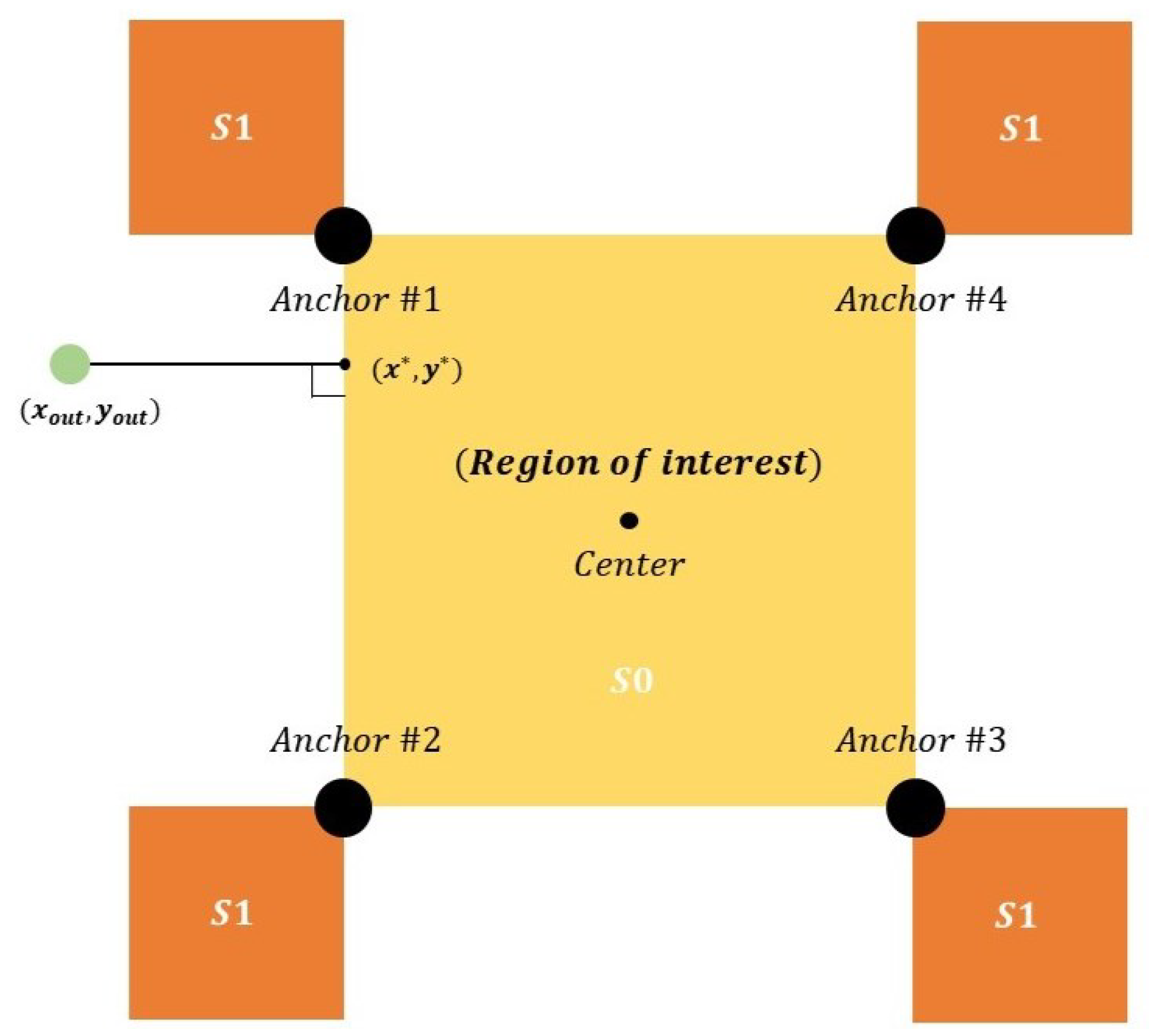
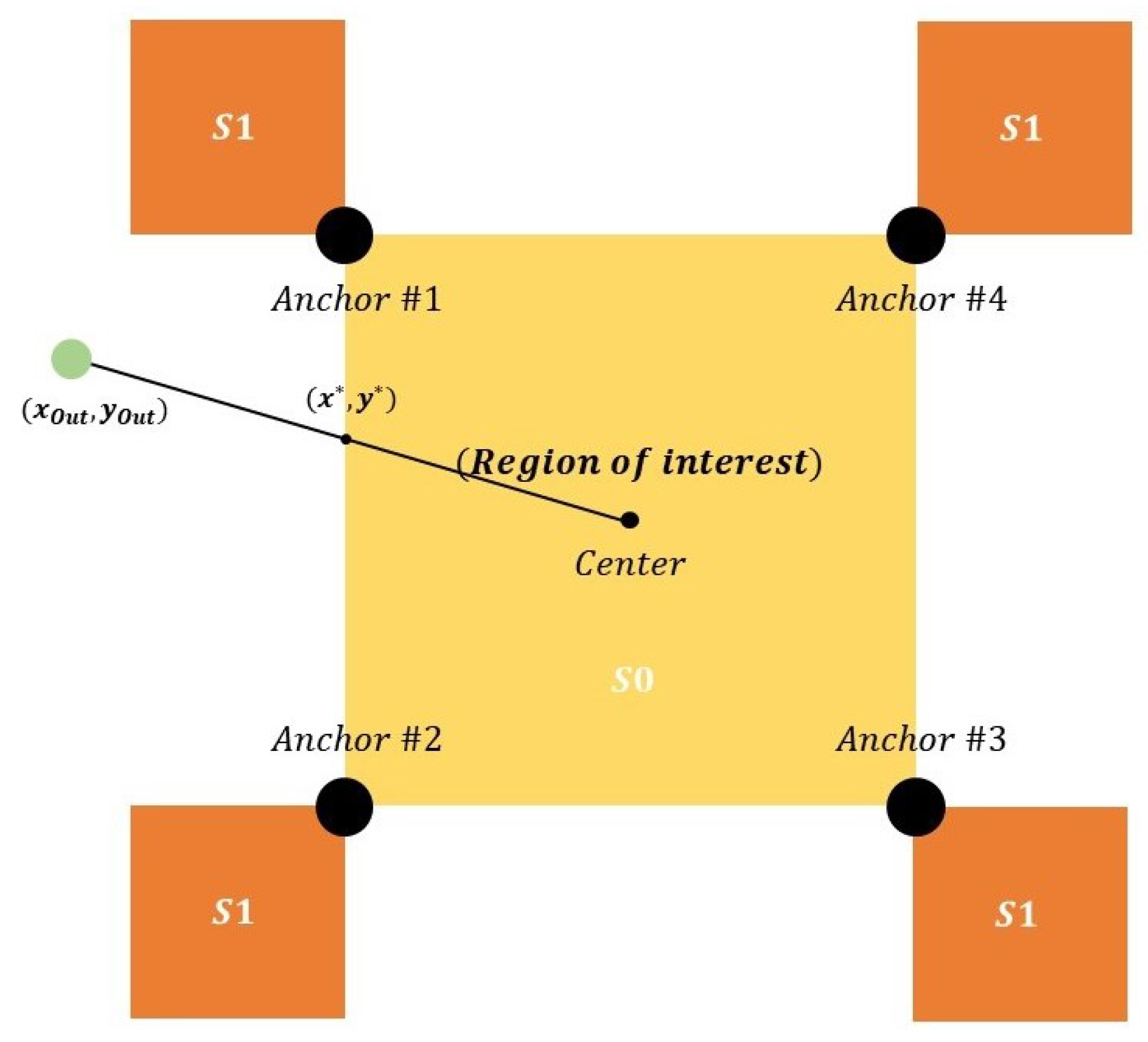
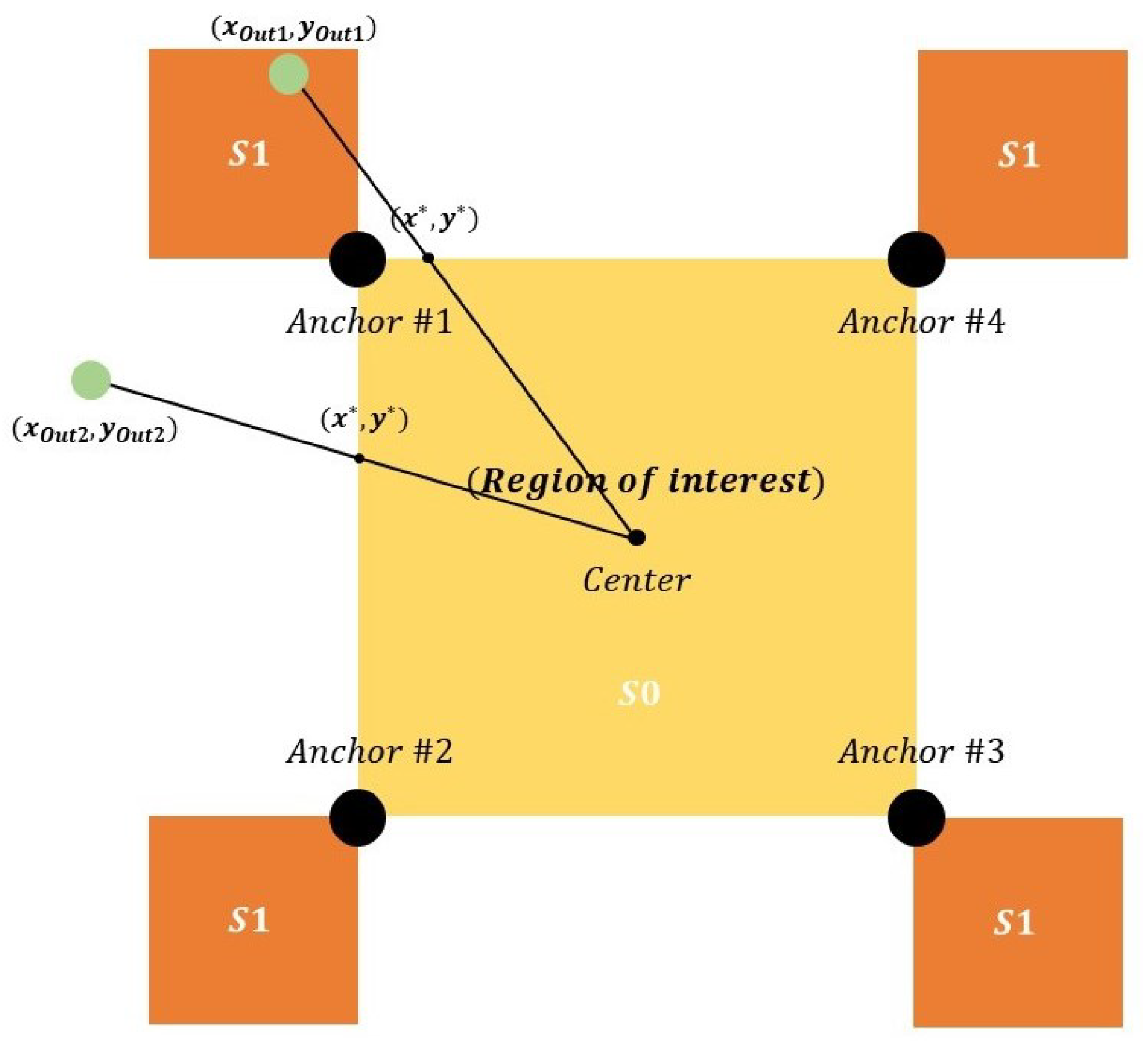
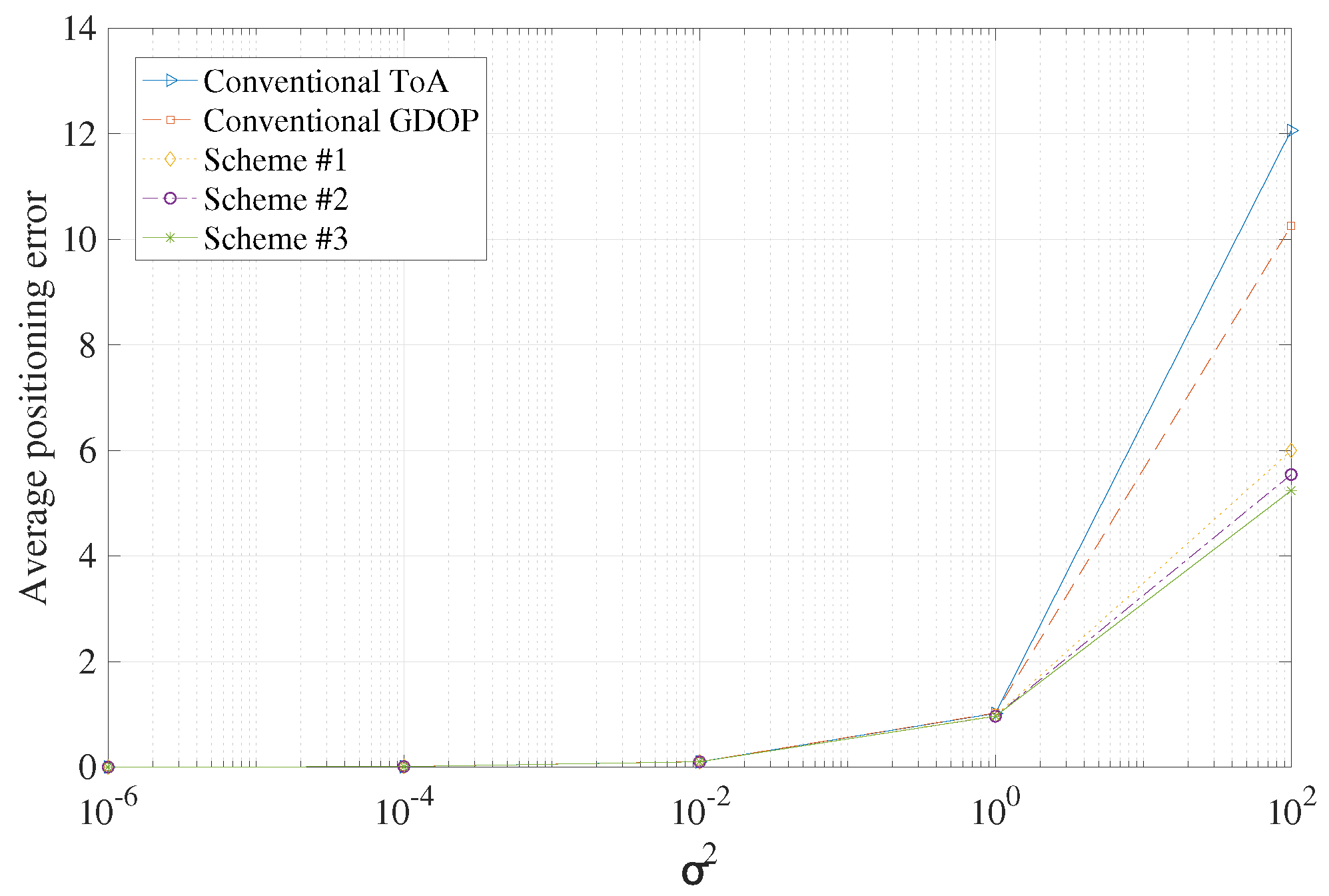
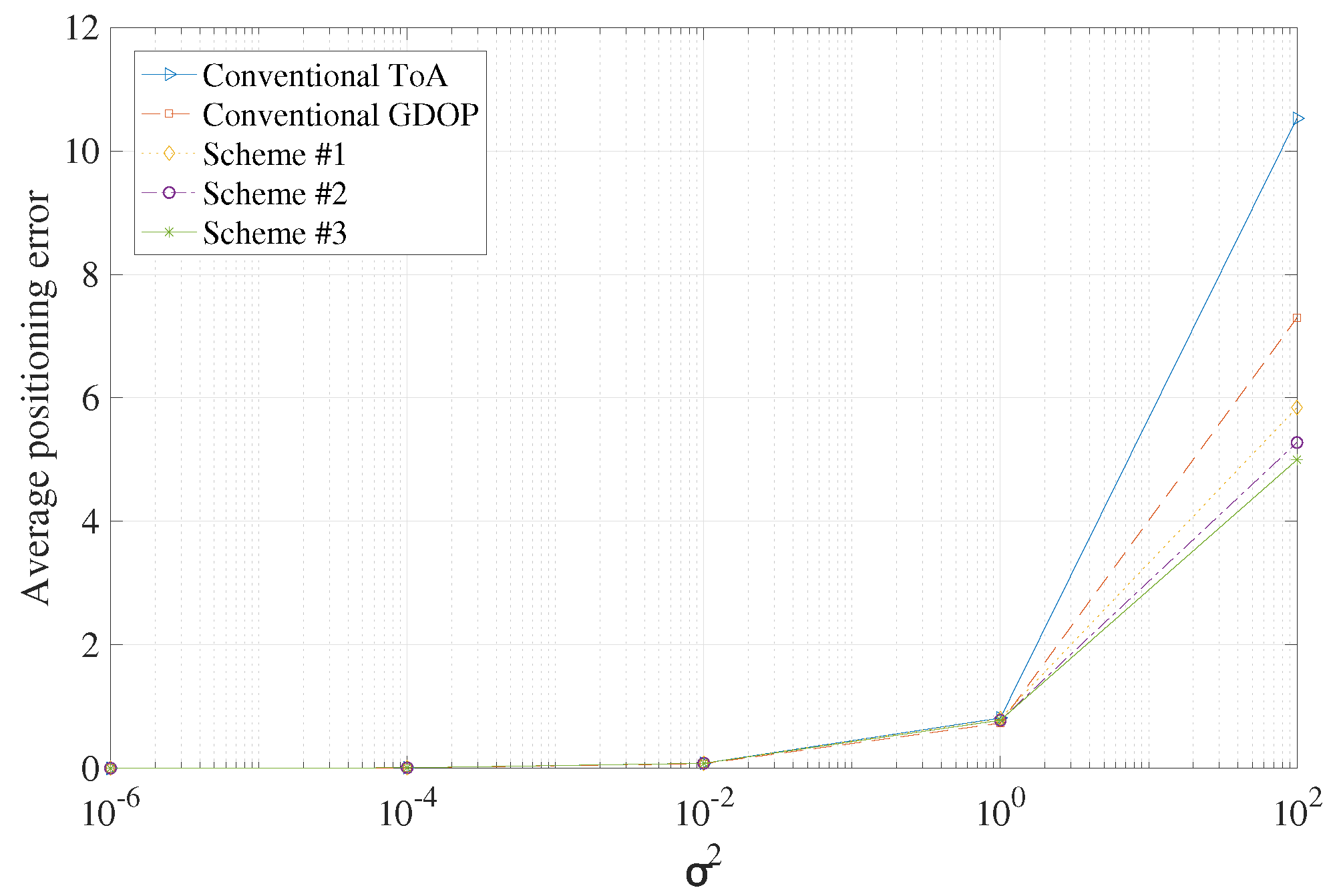


| S0 | S1 | S2 | |
|---|---|---|---|
| Conventional ToA | ToA | ||
| Scheme #1 | ToA | Correction of location information based on Euclidean distance | Project to the adjacent boundary by leveraging |
| Scheme #2 | ToA | Correction of location information based on Euclidean distance | Correction of location information by leveraging intersection of the adjacent boundary with the line outside the center |
| Scheme #3 | ToA | Correction of location information by learning intersection of the boundary with the line outside the center | Correction of location information by leveraging intersection of the adjacent boundary with the line outside the center |
| Difference in | |||||
|---|---|---|---|---|---|
| Conventional ToA | 0.0000 | 0.0001 | 0.0010 | 0.0072 | 1.8063 |
| Scheme #1 | 0.0000 | 0.0001 | 0.0013 | 0.0509 | 4.2573 |
| Scheme #2 | 0.0000 | 0.0001 | 0.0014 | 0.0616 | 4.7129 |
| Scheme #3 | 0.0000 | 0.0001 | 0.0015 | 0.0614 | 5.0164 |
| Difference in | |||||
|---|---|---|---|---|---|
| Conventional ToA | 0.0000 | 0.0008 | 0.0082 | 0.0840 | 3.2280 |
| Scheme #1 | 0.0000 | 0.0008 | 0.0080 | 0.0738 | 1.4560 |
| Scheme #2 | 0.0000 | 0.0008 | 0.0078 | 0.0477 | 2.0225 |
| Scheme #3 | 0.0000 | 0.0008 | 0.0078 | 0.0481 | 2.3023 |
Disclaimer/Publisher’s Note: The statements, opinions and data contained in all publications are solely those of the individual author(s) and contributor(s) and not of MDPI and/or the editor(s). MDPI and/or the editor(s) disclaim responsibility for any injury to people or property resulting from any ideas, methods, instructions or products referred to in the content. |
© 2024 by the authors. Licensee MDPI, Basel, Switzerland. This article is an open access article distributed under the terms and conditions of the Creative Commons Attribution (CC BY) license (https://creativecommons.org/licenses/by/4.0/).
Share and Cite
Park, S.; Hwang, J.; Byun, I.; Choi, S.W. High Accuracy Localization Scheme Using 1-Bit Side Information: Achievability from a GDoP Perspective. Electronics 2024, 13, 1574. https://doi.org/10.3390/electronics13081574
Park S, Hwang J, Byun I, Choi SW. High Accuracy Localization Scheme Using 1-Bit Side Information: Achievability from a GDoP Perspective. Electronics. 2024; 13(8):1574. https://doi.org/10.3390/electronics13081574
Chicago/Turabian StylePark, Suah, Jiyoung Hwang, Ilmu Byun, and Sang Won Choi. 2024. "High Accuracy Localization Scheme Using 1-Bit Side Information: Achievability from a GDoP Perspective" Electronics 13, no. 8: 1574. https://doi.org/10.3390/electronics13081574
APA StylePark, S., Hwang, J., Byun, I., & Choi, S. W. (2024). High Accuracy Localization Scheme Using 1-Bit Side Information: Achievability from a GDoP Perspective. Electronics, 13(8), 1574. https://doi.org/10.3390/electronics13081574






